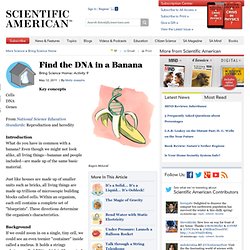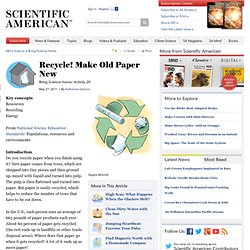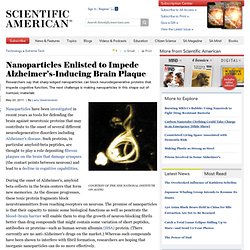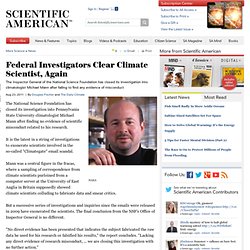

H5N1: the lab-made virus the U.S. fears could be made into a biological weapon. Water, water everywhere: Polarization dramatically affects H2O structure revealed through molecular dynamics simulation. (PhysOrg.com) -- Water is essential to more than its myriad roles in biological, chemical, geological, and other physical processes.

Having a precise description of water’s structure is critical to constructing accurate simulations of molecular events, including protein folding, substrate binding, macromolecular recognition, and complex formation. An important step forward in creating such a description has been demonstrated at Stanford University School of Medicine, where researchers discovered that polarization increases ordered water structure. Their findings will have a significant impact on biological processes.
Dr. Color-Changing Dots. Key concepts Traits Generations Natural selection.

The Magic of Gravity. Key concepts Gravity Friction Inertia (Newton's First Law of Motion) From National Science Education Standards: Position and motion of objects Introduction Have you ever seen a magician sweep a tablecloth quickly off a table and leave all the plates and glasses still in place?

The trick isn't magic at all—it's science! And you can use the same principle (without breaking any plates) to make a coin fall into a small container. Bend Water with Static Electricity. Key concepts Electricity Magnetism Gravity From National Science Education Standards: Light, heat, electricity and magnetism.

Yeast Alive! Watch Yeast Live and Breathe. Key concepts Life Food Metabolism From National Science Education Standards: Life cycles of organisms.

Find the DNA in a Banana. Key concepts Cells DNA Genes From National Science Education Standards: Reproduction and heredity Introduction What do you have in common with a banana?

Even though we might not look alike, all living things—bananas and people included—are made up of the same basic material. Recycle! Make Old Paper New. Key concepts Resources Recycling Energy From National Science Education Standards: Populations, resources and environments Introduction Do you recycle paper when you finish using it?

New paper comes from trees, which are chopped into tiny pieces and then ground up, mixed with liquid and turned into pulp. The pulp is then flattened and turned into paper. But paper is easily recycled, which helps to reduce the number of trees that have to be cut down. In the U.S., each person uses an average of 663 pounds of paper products each year. Nanoparticles Enlisted to Impede Alzheimer's-Inducing Brain Plaque. Nanoparticles have been investigated in recent years as tools for defending the brain against neurotoxic proteins that may contribute to the onset of several different neurodegenerative disorders including Alzheimer's disease.

Such proteins, in particular amyloid-beta peptides, are thought to play a role depositing fibrous plaques on the brain that damage synapses (the contact points between neurons) and lead to a decline in cognitive capabilities. During the onset of Alzheimer's, amyloid beta collects in the brain centers that form new memories. As the disease progresses, these toxic protein fragments block neurotransmitters from reaching receptors on neurons. Although the nanotech approach has great potential, the challenges are many, including finding a nanoparticle material that is effective yet also biocompatible and nontoxic. Why Carbon Dioxide Is a Greenhouse Gas. The Australia-based Galileo Movement touts a series of "basic facts" on carbon dioxide that attempt to explain why the greenhouse gas can't contribute to climate change.

John Smeed, the movement's co-founder, says the case against carbon dioxide as a global warming culprit is simply a matter of "junior school physics. " Federal Investigators Clear Climate Scientist, Again. The National Science Foundation has closed its investigation into Pennsylvania State University climatologist Michael Mann after finding no evidence of scientific misconduct related to his research.

It is the latest in a string of investigations to exonerate scientists involved in the so-called "Climategate" email scandal. Mann was a central figure in the fracas, where a sampling of correspondence from climate scientists purloined from a computer server at the University of East Anglia in Britain supposedly showed climate scientists colluding to fabricate data and smear critics. But a successive series of investigations and inquiries since the emails were released in 2009 have exonerated the scientists.
The final conclusion from the NSF's Office of Inspector General is no different. "No direct evidence has been presented that indicates the subject fabricated the raw data he used for his research or falsified his results," the report concludes. Power Walk: Shoe Inserts Using Conductive Droplets Could Charge Personal Electronics on the Go. From Nature magazine. Case study: why economics and addiction do not mix. Let me start by saying that I’m admittedly an economics fan. So much so that I nearly threw away my science and writing training and ran off into the sunset for an economics PhD. Cloud Formation May Be Linked to Cosmic Rays. From Nature magazine It sounds like a conspiracy theory: 'cosmic rays' from deep space might be creating clouds in Earth's atmosphere and changing the climate.
Yet an experiment at CERN, Europe's high-energy physics laboratory near Geneva, Switzerland, is finding tentative evidence for just that. The findings, published today in Nature, are preliminary, but they are stoking a long-running argument over the role of radiation from distant stars in altering the climate. For a century, scientists have known that charged particles from space constantly bombard Earth. Known as cosmic rays, the particles are mostly protons blasted out of supernovae. The number of cosmic rays that reach Earth depends on the Sun. Scientists agree on these basic facts, but there is far less agreement on whether cosmic rays can have a large role in cloud formation and climate change. Early results seem to indicate that cosmic rays do cause a change. Others disagree. Diamond World Discovered by Astronomers: Scientific American Podcast. Can Hurricanes Be Controlled? Researchers outline ways to advance scientific thinking in children.
The dangers of the internet: Invisible sieve. Toxoplasma Infected Rats Love Their Enemies: Scientific American Podcast. Predator Cat Odors Activate Sexual Arousal Pathways in Brains of Toxoplasma gondii Infected Rats. Your Brain in Love. Men and women can now thank a dozen brain regions for their romantic fervor. Researchers have revealed the fonts of desire by comparing functional MRI studies of people who indicated they were experiencing passionate love, maternal love or unconditional love. Together, the regions release neurotransmitters and other chemicals in the brain and blood that prompt greater euphoric sensations such as attraction and pleasure. Conversely, psychiatrists might someday help individuals who become dangerously depressed after a heartbreak by adjusting those chemicals.
Passion also heightens several cognitive functions, as the brain regions and chemicals surge. Genetically Engineered Food for All. FOOD prices are at record highs and the ranks of the hungry are swelling once again. Science & Nature - Secrets of the Sexes.